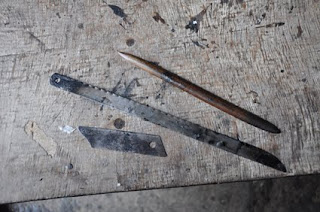Making Space:Sensing Place
In October 2009, along with artist Thurle Wright, I was awarded a Making Space:Sensing Place Fellowship; part of the HAT: Here and There International Exchange Programme, managed by A Fine Line:Cultural Practice. The Fellowship includes residencies with Britto Arts in Dhaka, Bangladesh, with Arts Reverie in Ahmedabad, Gujarat, with The V&A Museum of Childhood, Bethnal Green, London and with The Harley Gallery, Nottinghamshire. Working and collaborating with artists and craftspeople from the UK, Bangladesh and India, responding to the collections and spaces we encounter and sharing these experiences through a touring exhibition and educational workshops.
This blog, which is still developing and being added to, is a record of my experiences during the MS:SP Fellowship. Steven Follen.
www.stevenfollen.com
 I arranged with Sukanta Banik to re-visit Dhamrai Metal Casting, to see in more detail the way in which they make the wax models for casting and to learn more about how they work.
I arranged with Sukanta Banik to re-visit Dhamrai Metal Casting, to see in more detail the way in which they make the wax models for casting and to learn more about how they work. Dhamrai Metal Casting produces designs cast in bronze, brass and bell metal, using lost wax techniques that are hundreds of years old. Designs are based upon historical artefacts, some dating back to the 11th century (mostly statues of gods, godesses, animals and birds).
Dhamrai Metal Casting produces designs cast in bronze, brass and bell metal, using lost wax techniques that are hundreds of years old. Designs are based upon historical artefacts, some dating back to the 11th century (mostly statues of gods, godesses, animals and birds). 

 Small 'sprig' moulds, made from clay, are used when consistent details are needed.
Small 'sprig' moulds, made from clay, are used when consistent details are needed.











 A small kerosene lamp is used to give intense localised heat to tools and wax objects. Bowls of water are used to cool the wax once it is formed.
A small kerosene lamp is used to give intense localised heat to tools and wax objects. Bowls of water are used to cool the wax once it is formed.  The wax is made from parafin and beeswax. The correct combination is needed to ensure the wax is hard enough to hold its shape but soft enough to be modelled. Sheets are cast by pouring the wax into bowls of water.
The wax is made from parafin and beeswax. The correct combination is needed to ensure the wax is hard enough to hold its shape but soft enough to be modelled. Sheets are cast by pouring the wax into bowls of water.  The sheets are softened under the lamps and then cut, molded or rolled into the required shapes.
The sheets are softened under the lamps and then cut, molded or rolled into the required shapes. 





















 I thanked Sukanta and his family for their time and left to catch up with Shawon, who was filming at a local school.
I thanked Sukanta and his family for their time and left to catch up with Shawon, who was filming at a local school.
 I took a walk around Dhamrai by myself and stopped to watch the local jewellers working in their workshops.
I took a walk around Dhamrai by myself and stopped to watch the local jewellers working in their workshops.
 When soldering they use a oil burner and blow down a small tube to increase the heat and direction of the flame.
When soldering they use a oil burner and blow down a small tube to increase the heat and direction of the flame.




